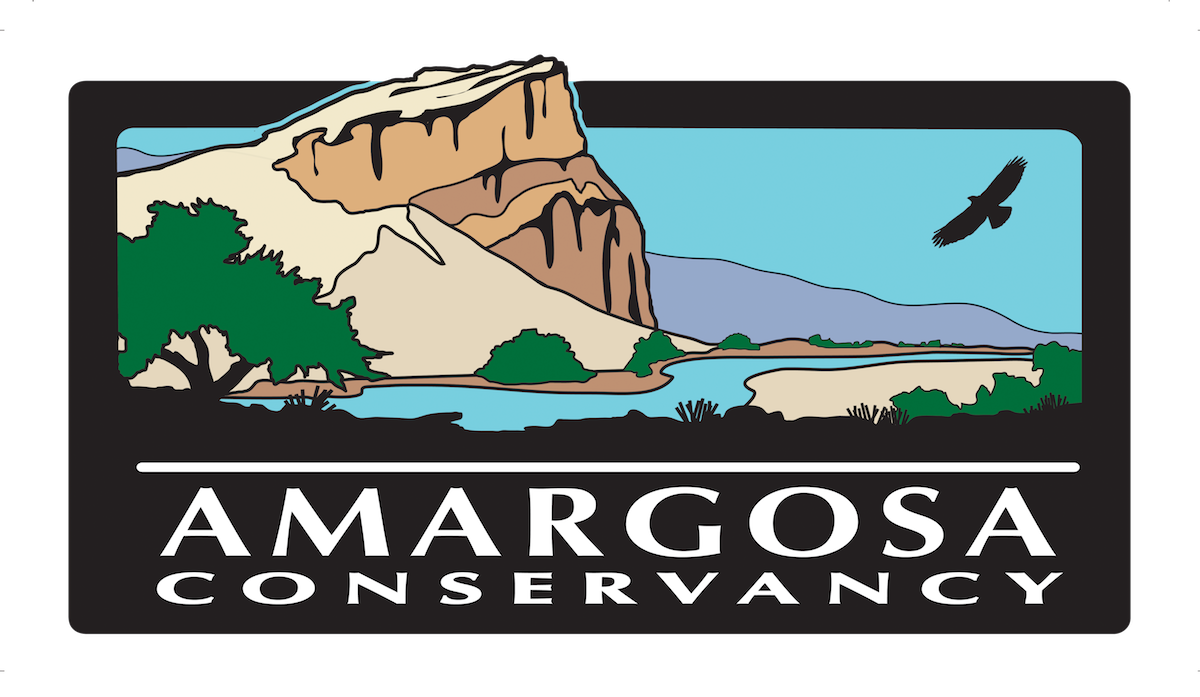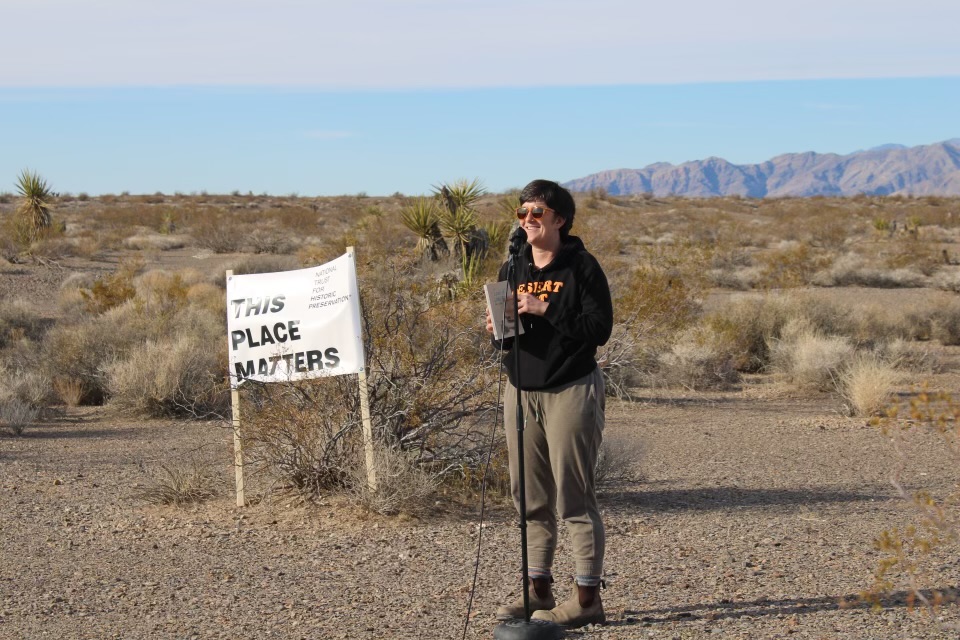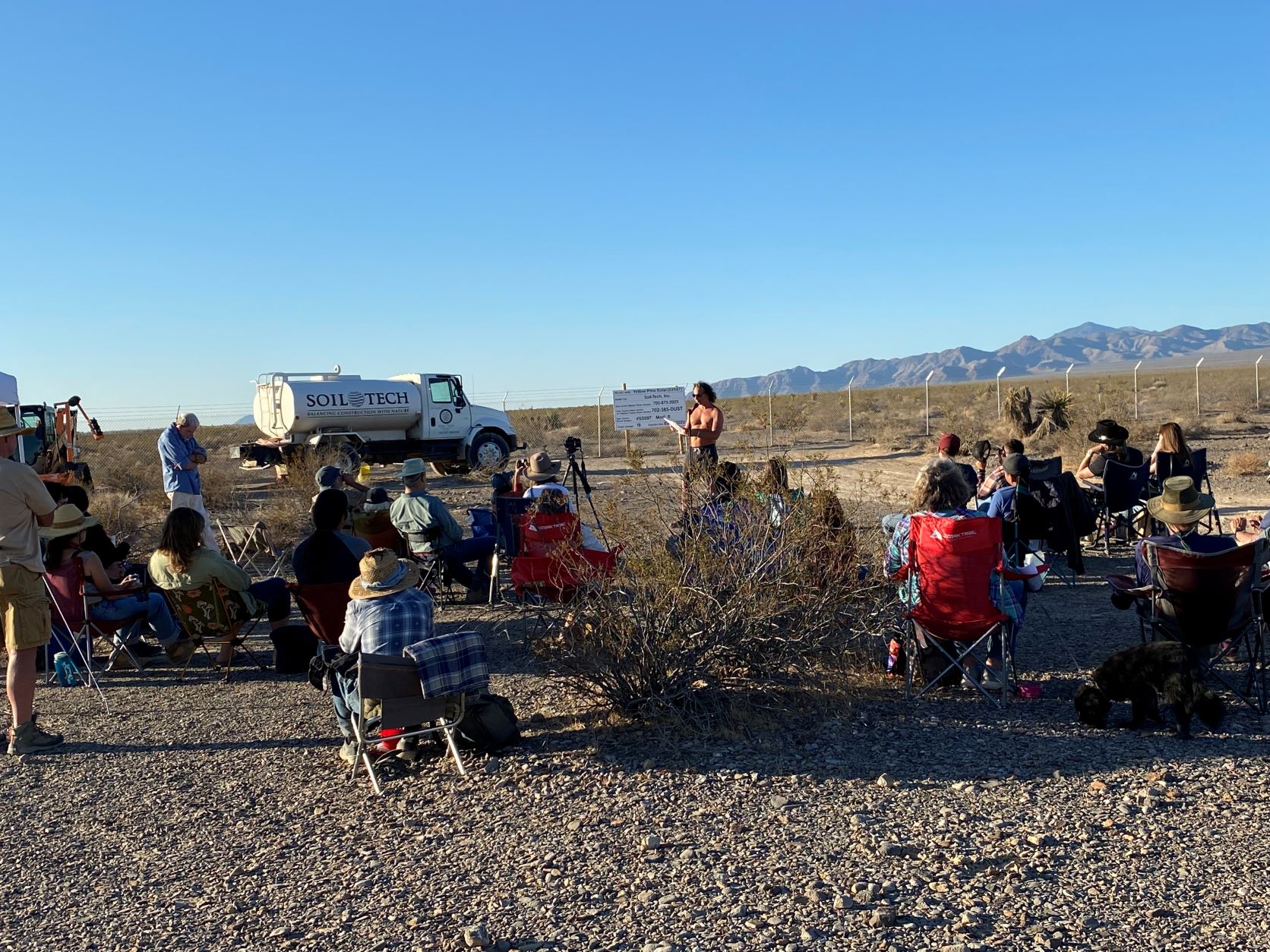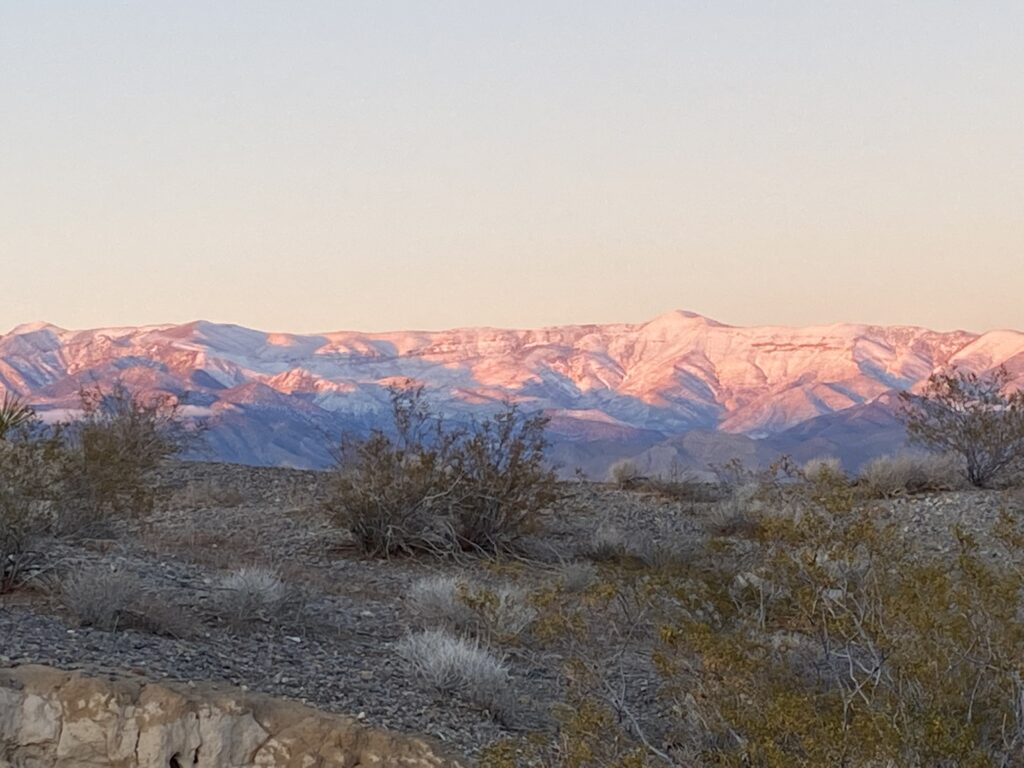Claire Vaye Watkins reading to the protest campout at the Yellow Pine solar construction project in Clark County, Nevada. Photo used with permission from Shannon Salter, 2021. mojavegreen.org
It’s a beautiful day on the Amargosa River.
The heat is predicted to break soon, meaning the days of the dreaded Tecopa bombers are numbered. The birds are coming back, and the bat scene is popping. This morning my beloved and I woke up before dawn and went for a soak at Borehole Spring, a place sacred to me. We soaked, watched the sun rise, and caught up with a neighbor. These lifeways are insulted and endangered by the BLM’s recent Western Solar Plan, which plainly considers this place a sacrifice zone.
Since 2020 I have, with other local grassroots desert activists, watched the construction of Yellow Pine, an industrial solar array in the south Pahrump Valley, 34 miles from my house. We watched the site go from an open, stunning old growth forest of yucca colonies and creosote rings, home to all kinds of amazing wildlife, including desert tortoises, to a fenced off, scraped, sprayed, dusty, likely toxic and certainly dead place. We watched endangered desert tortoises “mitigated” from the Yellow Pine site, meaning: dug up and moved to the dry spring across the road, away from their burrows, food, water, and mates. There, drought-desperate badgers clawed open the shells of over thirty of the tortoises and ate them. Yellow pine is just the first of many industrial solar arrays proposed here. If we do not reexamine this transition to renewable energy and adjust course, the whole south Pahrump Valley becomes Yellow Pine, and much of America’s outback a sacrifice zone.
The world economy must transition off fossil fuels. That’s inarguable, a question not of “if” or “when” but “how.” For decarbonization to have any chance of becoming politically viable in this country, American environmentalists need to win the hearts and minds of the people most impacted by renewable energy production. Decarbonization is essential, but it’s also abstract. It’s hard to see, to feel, what my neighbors and I living on the Amargosa watershed gain from an industrial array like Yellow Pine, which was built by NextEra Energy, and profits only that corporation’s shareholders. BLM’s Environmental Impact Statement on Yellow Pine admitted that once construction was complete the industrial array would provide “0-5 jobs,” and would likely be operated remotely, from Florida. Sustainable energy is important for sure, but right now it’s not a winning proposition. As far as concrete impacts on peoples’ lives, what Yellow Pine gives my neighbors and I, as far as I can tell, is an increased risk of asthma and valley fever.
And now, with the current Western Solar Plan, the federal government is looking to replicate the fiasco of industrial solar on intact ecosystems across the entire American West. The current plan would enable energy companies to exact massive and avoidable carnage throughout the region, especially in the Great Basin and Mojave Desert. There is much to be lost on this path—biodiversity, cultural resources, air quality, healthy carbon sequestering forests, wide open spaces. The Amargosa River watershed is most definitely on the chopping block, given the immense amount of water these arrays consume for construction and operations. And perhaps among most tragic losses will be the trust of rural people across the West, whose sacred places and treasured lifeways will be destroyed, their peace and serenity desecrated, their lungs and those of their children inundated with dust. If we sacrifice their home we also sacrifice any chance of their support for the transition off fossil fuels.
But this green energy infrastructure has to go somewhere, the familiar argument goes. I agree, and have two suggestions. First, there is plenty of land across the West already ruined by wasteful agriculture, overdevelopment, and sprawl. Solar should go in these places now, instead of destroying intact habitat, slurping up fragile desert rivers, and driving locals into deeper alliance with violent fascists. We have to offer the people out here something concrete, something like the shade of solar canopies over parking lots and freedom from energy bills from solar panels on their rooftops. The built environment should obviously be the first place we put solar: this is the happy picture people see when they hear “solar power,” not far-flung industrial arrays built on stunning wilderness. But NextEra, the company that built Yellow Pine, has lobbied to sabotage rooftop solar, making it harder and harder for homeowners with solar panels to sell the energy they make back to the grid.
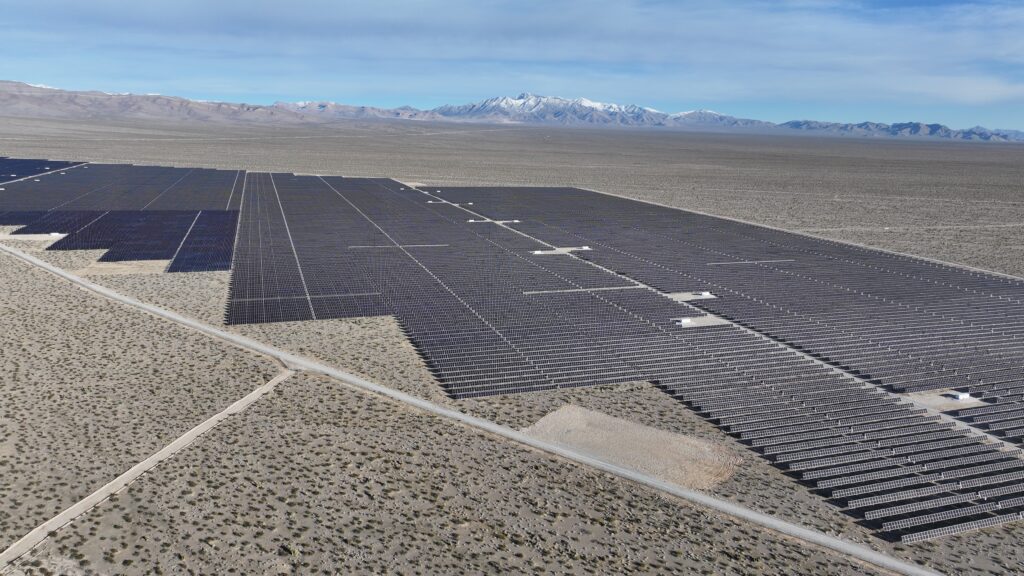
Yellow Pine solar farm in February 2024. Photo from Patrick Donnelly.
My neighbors and I have asked before: where is the people’s solar? The federal government should have a program where they offer to put free solar panels on the roofs and parking lots of everyone who wants it, which I think would be a whole lot of us, from across the political spectrum and beyond it. Community-owned distributed solar is a smarter, fairer way to rebuild our energy infrastructure and kick our addiction to fossil fuels. It’s also a real, tangible way to improve the lives of people living in energy producing parts of the country, like the Amargosa basin.
So why aren’t the feds knocking on my door offering to put solar panels on my house? One reason that seems plain to me is that a distributed network threatens the record-high profits of companies like NextEra, which is why they lobby so aggressively to sabotage distributed solar. These companies and their shareholders much prefer to keep their energy monopolies. Letting them build industrial solar arrays on living public land converts a solar, a free, abundant energy source, into an energy source that is owned and sold. It’s extractive business as usual, like putting an oil derrick on the sun.
Just as there is a long history of environmental injustice on this land, beginning with its theft, there is a long history of defiance here. I was a second grader at J.G. Johnson elementary in Pahrump when the U.S. government exploded “Divider,” the last of over 1,000 full-scale nuclear weapons detonated on and in what was then called the Nevada Test Site, near the headwaters of the Amargosa River. It took nearly fifty years of sustained resistance by tribes and peace activists to end that dark folly, and we still live in its long shadow. But we also live in the strength and resilience of those who stood for justice, saying, “Nevada is not a wasteland.”
So, I say it now: the Amargosa is not a wasteland. The Mojave is not a wasteland. The Great Basin is not a wasteland. Arizona, Wyoming, New Mexico, Idaho, Washington, Oregon, and Utah are not wastelands. We must not let them become one. We must not let the same profiteers whose bottomless greed got us into this mess sabotage the renewable energy transition we need so desperately. We must not let the crown jewel of the Mojave be plundered by these marauders. We must show up for frontline communities, for the people, plants, and animals whose real lives are at stake. We must not let federal bureaucrats nor politicians and their corporate puppet masters turn the Great American Deserts into the oilfields of west Texas. They will not make the beautiful Amargosa River Basin a 21st century Saudi Arabia.
I’m grateful to the Amargosa Conservancy for standing up for frontline communities like mine in Tecopa, Shoshone, Amargosa Valley, Beatty and beyond. I’m heartened that the Western Solar Plan is not yet a done deal. There is hope. We have one last fighting chance to tell BLM to take the Amargosa and similar sacred lands and waters off the chopping block. We have a chance to show up for the people most marginalized, disenfranchised, and poisoned by corporate America. We have a chance to put solar in the cities. We have a chance to insist on an energy transition that honors the miracle of life. Let’s take it.
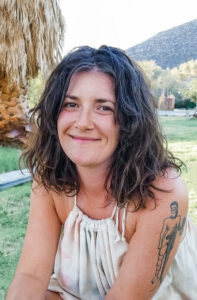 Claire Vaye Watkins is a resident of Tecopa, on the Amargosa River in Inyo County, California, and the author of Battleborn, Gold Fame Citrus, and I Love You But I’ve Chosen Darkness. Her next novel is about the Yellow Pine solar project and the protest action during its construction.
Claire Vaye Watkins is a resident of Tecopa, on the Amargosa River in Inyo County, California, and the author of Battleborn, Gold Fame Citrus, and I Love You But I’ve Chosen Darkness. Her next novel is about the Yellow Pine solar project and the protest action during its construction.
